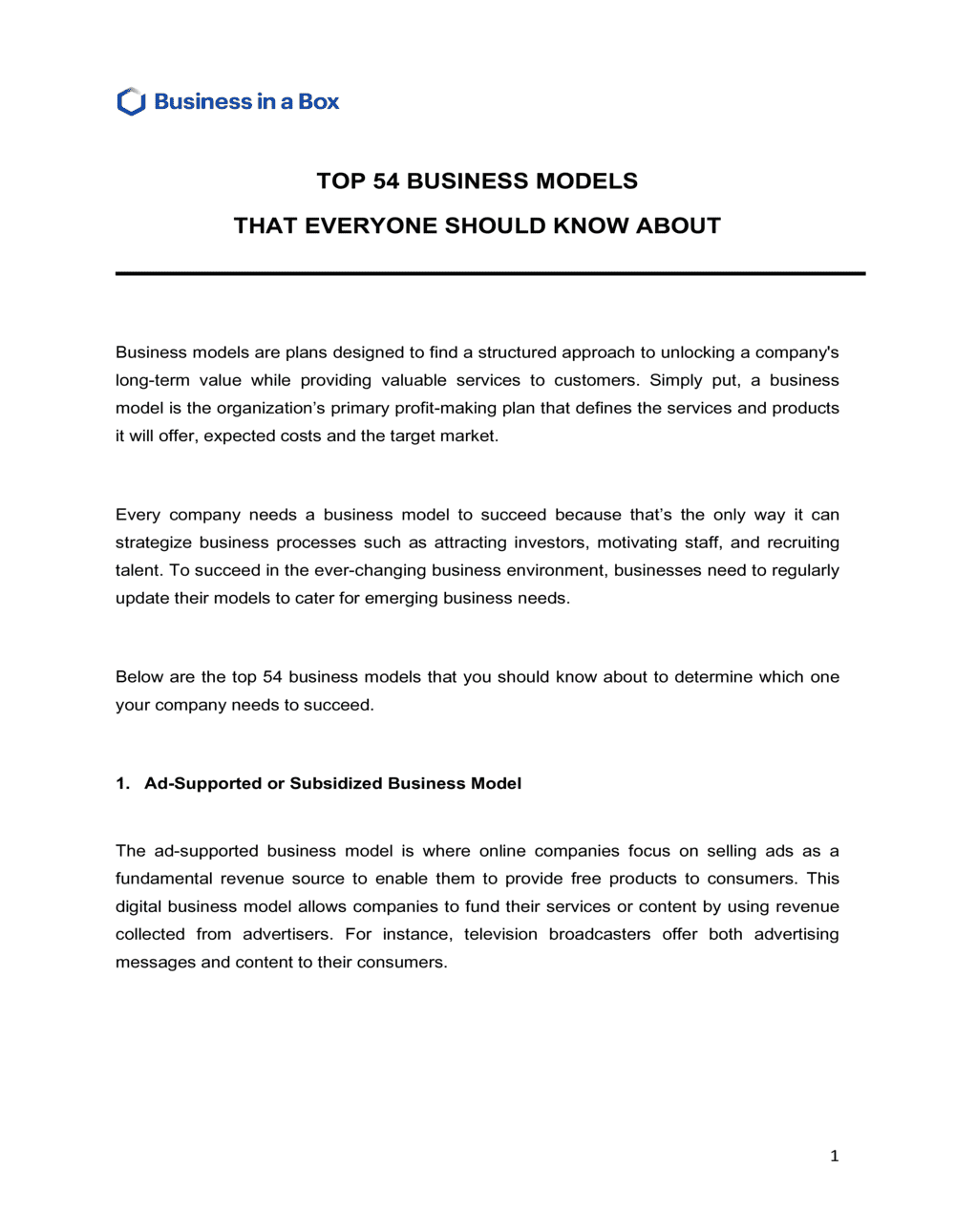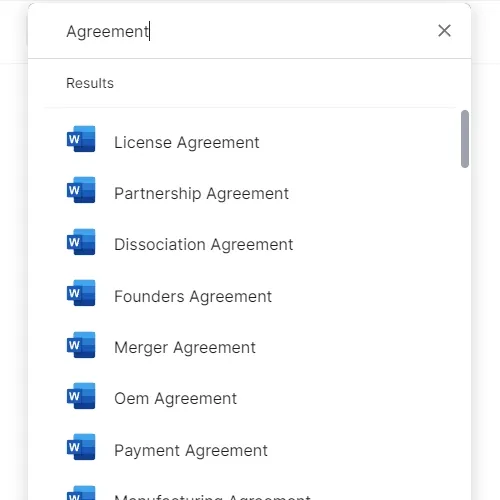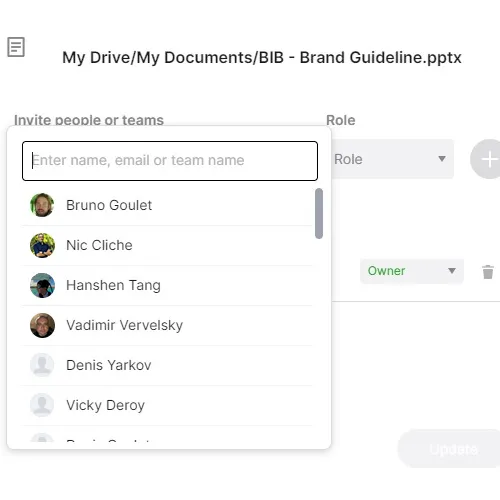Top 54 Business Models Template

Sample of Document Content
This top 54 business models template has 14 pages and is a MS Word file type listed under our business plan kit documents.
Top 54 business models template
TOP 54 BUSINESS MODELS THAT EVERYONE SHOULD KNOW ABOUT Business models are plans designed to find a structured approach to unlocking a company's long-term value while providing valuable services to customers. Simply put, a business model is the organization's primary profit-making plan that defines the services and products it will offer, expected costs and the target market. Every company needs a business model to succeed because that's the only way it can strategize business processes such as attracting investors, motivating staff, and recruiting talent. To succeed in the ever-changing business environment, businesses need to regularly update their models to cater for emerging business needs. Below are the top 54 business models that you should know about to determine which one your company needs to succeed. Ad-Supported or Subsidized Business Model The ad-supported business model is where online companies focus on selling ads as a fundamental revenue source to enable them to provide free products to consumers. This digital business model allows companies to fund their services or content by using revenue collected from advertisers. For instance, television broadcasters offer both advertising messages and content to their consumers. A Mixture of Chain and Franchise Model A chain model is a business approach whereby a company expands by acquiring and operating other companies in the same industry. On the other hand, the franchise model is one whereby a renowned business (franchisor) permits third-party companies to conduct business operations and distribute services and products using its business systems and name at a fee. The mixed chain and franchise model is a model that incorporates both operated (chain) and licensed stores (franchise). Affiliate Business Model This business model involves marketing and selling other companies' services or products. Companies using the affiliate marketing tool make money by earning commissions from featured services and products. Aggregator Business Model This business framework is, in a way, a platform model that comes with unique characteristics. For example, the company acting as the aggregator can serve as the middleman connecting suppliers to consumers. Google's search engine is an example of an aggregator. Agency-Based Model This business approach involves clients paying a specific fee to an agency to use its services. For instance, digital marketing agencies get paid by clients to help them market their products online through SEO ranking and generating potential leads. Asymmetric Business Model In an asymmetric model, a company does not directly monetize its consumers. Instead, it leverages user data together with multiple technologies such as algorithms, which they sell to an advertiser in return for visibility. Attention Merchant Model This business model is used by companies that essentially generate revenue through gathering human attention. You can think of Twitter or Facebook as key companies using attention merchants as a business model. Attention merchants must keep users hooked because a single tweet from prominent personalities can reduce a company's market share by billions. Barbell Business Strategy The Barbell model involves ensuring that 90% of the company's capital is safe, while using the remaining percentage for risky, potentially profitable investments. A company that adopts this strategy has a binary model wherein one end is conservative, and the other end is aggressive. Therefore, it creates a potent mixture. Bidding Multi-Brand Platform Strategy This business strategy is a platform-based model that allows a company to connect companies with their consumers, for instance, apps or platforms that allow for restaurant selection and order delivery. Companies that adopt this strategy earn through commission on services or products ordered. Blitzscaler-Mode Business Strategy At its core, the Blitzscaling business model focuses on growing your brand faster than your competitors. This model involves massive, continuous investment in various markets to help the business establish unbeatable built-in growth. It is a risky model, especially because it prioritizes speed over efficiency. Blockchain-Based Model A blockchain is a form of distributed ledger, which depends on cryptographic tools to handle interactions, transactions and any other issues that involve an exchange between two or more people in an anonymous and decentralized manner. The blockchain-based business strategy involves creating a decentralized social connection between multiple stakeholders. This model is primarily based on the blockchain protocol. Bundler Business Model This strategy is a distribution-propelled model where market leaders exploit the benefits associated with being at the top. The bundling model involves a value chain block series grouping themselves to lock in customers. As a result, they utilize their distribution channels to restrict external competition and increase their market share in other areas. Cash Machine (or Cash Conversion Cycle) Model This business model involves low-profit-margin companies finding partners to sponsor their business operations to achieve their short-term liquidity needs. Therefore, the company can survive on a minimal profit margin but still cater for its financial needs. One great example of using this model is none other than Amazon. A Discount Business Strategy Focusing on High Quality Using price to increase a company's competitive power isn't a new thing. Yet, this approach is not the best when it comes to creating sustainable business models. However, this business model introduces the concept of maintaining high quality while keeping the prices as low as possible to ensure customer retention and growth. Distribution-Based Business Model This business model involves companies depending on their ability to acquire one or multiple distribution networks to connect with their customers. Although no organization can live without a distribution channel, those that focus on customer markets should be excellent in developing distribution channels. This way, they'll unlock their long-term value. Direct-to-Consumer Business Model The strategy is essentially based on companies accessing their customers directly without the need for intermediaries. The more a firm can reach its customers directly, the better, because it can control its customers' perceptions through its marketing campaigns. Direct Sales Business Strategy With companies adopting advanced technologies and machines like automated robots, they have lost the personal touch with their customers. The direct sales model has become a critical business model to reconnect with customers person-to-person and restore the personal touch. However, for you to succeed when using the direct sales business approach, you need to understand your target audience's qualifications. E-Commerce Marketplace Model This business model involves using the power of the internet to reconnect to enable buyers to buy products online. Sellers can sell their products through a well-established e-commerce giant like Amazon. Amazon will then handle the picking, packaging, and shipping, easing you from the burden associated with getting your product to the buyer. Educational Niche Business Strategy As the name suggests, this model focuses on the education sector. It involves developing a platform where learners and teachers can get study materials like quizzes at a fee. Although it offers freemium services, to enjoy advanced features from this model, you must pay a subscription fee. Family-Owned Integrated Model This business model begins by assuming that you have established a multi-billion-dollar business that you fully control
Reviewed on

Sample of Document Content
This top 54 business models template has 14 pages and is a MS Word file type listed under our business plan kit documents.
Sample of our top 54 business models template:
TOP 54 BUSINESS MODELS THAT EVERYONE SHOULD KNOW ABOUT Business models are plans designed to find a structured approach to unlocking a company's long-term value while providing valuable services to customers. Simply put, a business model is the organization's primary profit-making plan that defines the services and products it will offer, expected costs and the target market. Every company needs a business model to succeed because that's the only way it can strategize business processes such as attracting investors, motivating staff, and recruiting talent. To succeed in the ever-changing business environment, businesses need to regularly update their models to cater for emerging business needs. Below are the top 54 business models that you should know about to determine which one your company needs to succeed. Ad-Supported or Subsidized Business Model The ad-supported business model is where online companies focus on selling ads as a fundamental revenue source to enable them to provide free products to consumers. This digital business model allows companies to fund their services or content by using revenue collected from advertisers. For instance, television broadcasters offer both advertising messages and content to their consumers. A Mixture of Chain and Franchise Model A chain model is a business approach whereby a company expands by acquiring and operating other companies in the same industry. On the other hand, the franchise model is one whereby a renowned business (franchisor) permits third-party companies to conduct business operations and distribute services and products using its business systems and name at a fee. The mixed chain and franchise model is a model that incorporates both operated (chain) and licensed stores (franchise). Affiliate Business Model This business model involves marketing and selling other companies' services or products. Companies using the affiliate marketing tool make money by earning commissions from featured services and products. Aggregator Business Model This business framework is, in a way, a platform model that comes with unique characteristics. For example, the company acting as the aggregator can serve as the middleman connecting suppliers to consumers. Google's search engine is an example of an aggregator. Agency-Based Model This business approach involves clients paying a specific fee to an agency to use its services. For instance, digital marketing agencies get paid by clients to help them market their products online through SEO ranking and generating potential leads. Asymmetric Business Model In an asymmetric model, a company does not directly monetize its consumers. Instead, it leverages user data together with multiple technologies such as algorithms, which they sell to an advertiser in return for visibility. Attention Merchant Model This business model is used by companies that essentially generate revenue through gathering human attention. You can think of Twitter or Facebook as key companies using attention merchants as a business model. Attention merchants must keep users hooked because a single tweet from prominent personalities can reduce a company's market share by billions. Barbell Business Strategy The Barbell model involves ensuring that 90% of the company's capital is safe, while using the remaining percentage for risky, potentially profitable investments. A company that adopts this strategy has a binary model wherein one end is conservative, and the other end is aggressive. Therefore, it creates a potent mixture. Bidding Multi-Brand Platform Strategy This business strategy is a platform-based model that allows a company to connect companies with their consumers, for instance, apps or platforms that allow for restaurant selection and order delivery. Companies that adopt this strategy earn through commission on services or products ordered. Blitzscaler-Mode Business Strategy At its core, the Blitzscaling business model focuses on growing your brand faster than your competitors. This model involves massive, continuous investment in various markets to help the business establish unbeatable built-in growth. It is a risky model, especially because it prioritizes speed over efficiency. Blockchain-Based Model A blockchain is a form of distributed ledger, which depends on cryptographic tools to handle interactions, transactions and any other issues that involve an exchange between two or more people in an anonymous and decentralized manner. The blockchain-based business strategy involves creating a decentralized social connection between multiple stakeholders. This model is primarily based on the blockchain protocol. Bundler Business Model This strategy is a distribution-propelled model where market leaders exploit the benefits associated with being at the top. The bundling model involves a value chain block series grouping themselves to lock in customers. As a result, they utilize their distribution channels to restrict external competition and increase their market share in other areas. Cash Machine (or Cash Conversion Cycle) Model This business model involves low-profit-margin companies finding partners to sponsor their business operations to achieve their short-term liquidity needs. Therefore, the company can survive on a minimal profit margin but still cater for its financial needs. One great example of using this model is none other than Amazon. A Discount Business Strategy Focusing on High Quality Using price to increase a company's competitive power isn't a new thing. Yet, this approach is not the best when it comes to creating sustainable business models. However, this business model introduces the concept of maintaining high quality while keeping the prices as low as possible to ensure customer retention and growth. Distribution-Based Business Model This business model involves companies depending on their ability to acquire one or multiple distribution networks to connect with their customers. Although no organization can live without a distribution channel, those that focus on customer markets should be excellent in developing distribution channels. This way, they'll unlock their long-term value. Direct-to-Consumer Business Model The strategy is essentially based on companies accessing their customers directly without the need for intermediaries. The more a firm can reach its customers directly, the better, because it can control its customers' perceptions through its marketing campaigns. Direct Sales Business Strategy With companies adopting advanced technologies and machines like automated robots, they have lost the personal touch with their customers. The direct sales model has become a critical business model to reconnect with customers person-to-person and restore the personal touch. However, for you to succeed when using the direct sales business approach, you need to understand your target audience's qualifications. E-Commerce Marketplace Model This business model involves using the power of the internet to reconnect to enable buyers to buy products online. Sellers can sell their products through a well-established e-commerce giant like Amazon. Amazon will then handle the picking, packaging, and shipping, easing you from the burden associated with getting your product to the buyer. Educational Niche Business Strategy As the name suggests, this model focuses on the education sector. It involves developing a platform where learners and teachers can get study materials like quizzes at a fee. Although it offers freemium services, to enjoy advanced features from this model, you must pay a subscription fee. Family-Owned Integrated Model This business model begins by assuming that you have established a multi-billion-dollar business that you fully control
Easily Create Any Business Document You Need in Minutes.

Download or open template
Access over 3,000+ business and legal templates for any business task, project or initiative.

Edit and fill in the blanks
Customize your ready-made business document template and save it in the cloud.

Save, Share, Export, or Sign
Share your files and folders with your team. Create a space of seamless collaboration.


